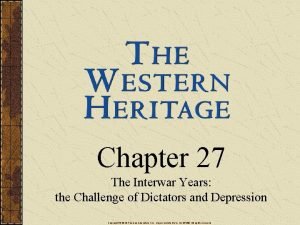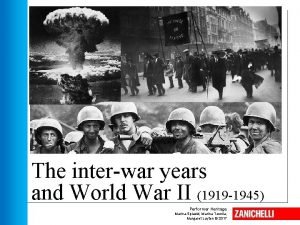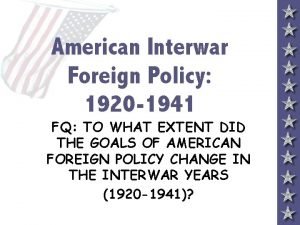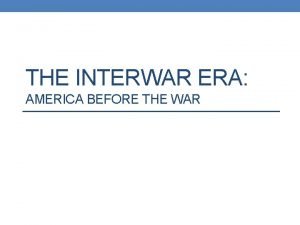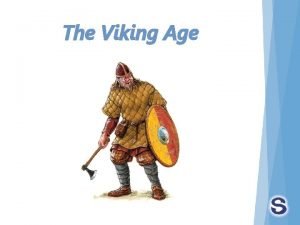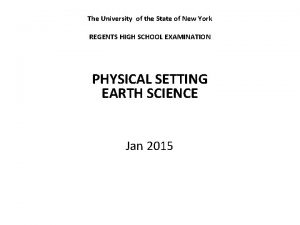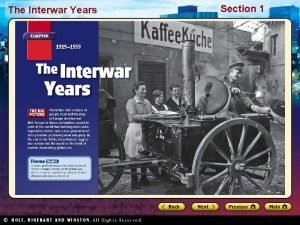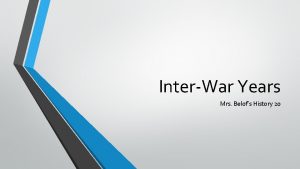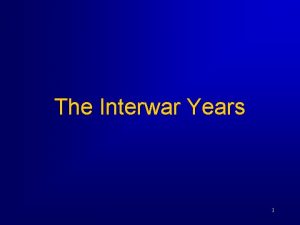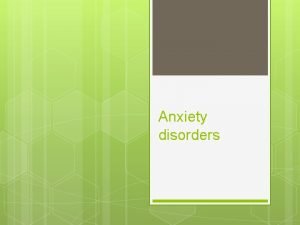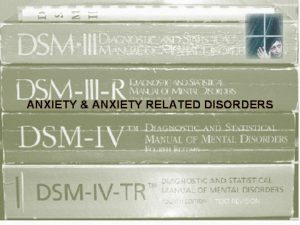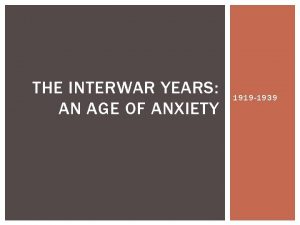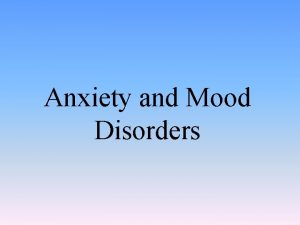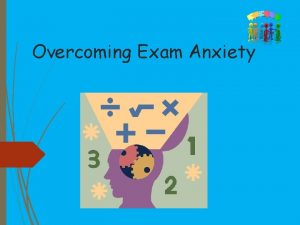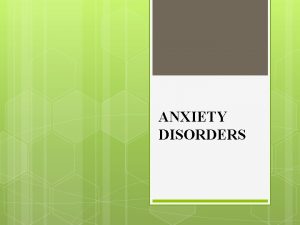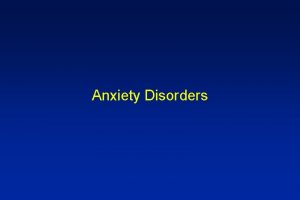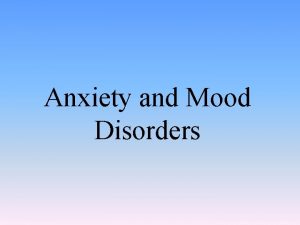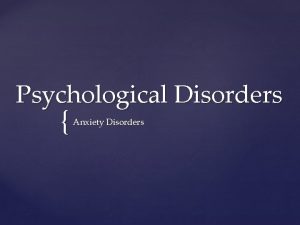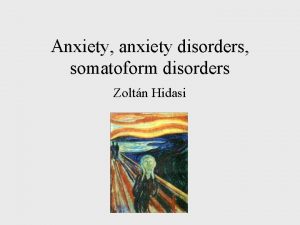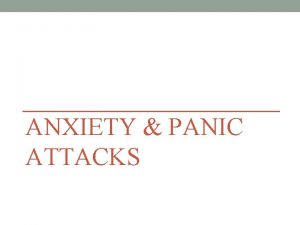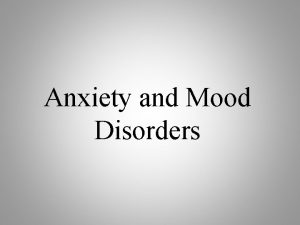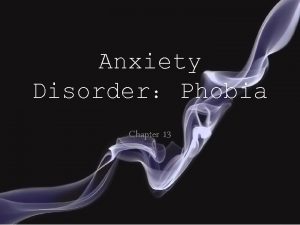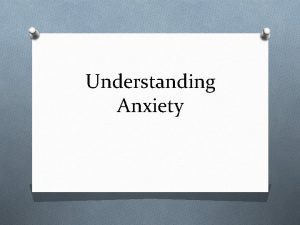Age of Anxiety The Interwar Years Age of


























- Slides: 26

Age of Anxiety The Interwar Years

Age of Anxiety End of Old Order • End of Hapsburg, Hohenzollern and Romanov Rule • Emergence of Totalitarianism in Stalinist Russia, Fascist Italy and Fascist Germany • The Great Depression on the 1930’s created political and social crises

Age of Anxiety • WWI was a staggering blow to Western Civilization • Many people felt as if they had been turned upside down and they had little control to change things for the better • People saw themselves living in a perpetual state of crisis

Age of Anxiety Modern Philosophy • Before 1914 most people still believed in progress, reason and the rights of the individual. • Optimistic view was the result of progress of the past two centuries. • After the war, new and upsetting ideas began to spread through the entire population • Critics of the pre-war world anticipated many of the post-war ideas. • Rejected the general faith in progress and the power of the rational human mind.

Age of Anxiety Friedrich Nietzsche • One of the most important critics of the rationalism of the Enlightenment • In Thus Sake Zarathustra (18831885), he blasted religion and claimed that "God is Dead” – Claimed Christianity embodied a “slave morality, ” which glorified weakness, envy, and mediocrity. – Individualism had to be quashed • In Will to Power (1888) he wrote that only the creativity of a few supermen – Ubermenschen - could successfully reorder the world. • Though not widely read by his contemporaries, his writings seemed relevant in the atmosphere of post-World War I pessimism

Age of Anxiety Henri Bergson • 1890 s, convinced many young people that immediate experience and intuition were as important as rational and scientific thinking for understanding reality.

Age of Anxiety Georges Sorel • Syndicalism (a manifestation of anarchism) • Believed socialism would come to power through a great, violent strike (General Strike) of all working people. • Ideas foreshadowed the Bolshevik Revolution; control by an elite few

Age of Anxiety Freudian Psychology • was first developed in the late 1880 s by Sigmund Freud • Freud one of three most important thinkers of 19 th century (along with Marx and Darwin) • Traditional psychology assumed a single, unified conscious mind processed sense experiences in a rational and logical way. • Freudian psychology seemed to reflect the spirit of the early 20 th century, with its emphasis on men and women as greedy, grasping, irrational creatures. • Became an international movement by 1910 and received popular attention after 1918, especially in Protestant countries of Northern Europe and the U. S.

Age of Anxiety Freudian Psychology • Freud asserted that because the human unconscious (ID) is driven by sexual, aggressive, and pleasureseeking desires, humans are therefore NOT rational! ID battles Ego & Superego – Ego: Rationalizing conscious mediates what a person can do. – Superego: Ingrained moral values specifies what a person should do. • Shattered enlightenment view of rationality and progress.

Age of Anxiety Freudian Psychology • Freud agreed with Nietzsche that mechanisms of rational thinking and traditional morals values can be too strong on the human psyche – They can repress sexual desires too effectively, crippling individuals and entire peoples with guilt and neurotic fears – Many opponents and some enthusiasts interpreted Freud as saying that the first requirement for mental health is an uninhibited sex life – After WWI, the popular interpretation of Freud reflected and encouraged growing sexual experimentation, particularly among middle-class women.

Age of Anxiety Anti-utopian Authors · Oswald Spengler (1880 -1936) – The Decline of the West – Every culture experiences a life cycle of growth and decline; Western civilization was in its old age, and death was approaching in the form of conquest by the yellow race. • T. S. Eliot, "The Wasteland": Depicted a world of growing desolation. • Reich Maria Remarque: All Quiet on the Western Front (1929) • Franz Kafka: Portrays helpless individuals crushed by inexplicably hostile forces. – The Trial; The Castle; The Metamorphosis

Age of Anxiety Existentialism · Existentialism took root in Continental countries after the horros of World War II and the Atomic age. – Saw life as absurd – Viewed a world where the individual has to find his own meaning; most were atheists • Jean-Paul Sartre: Humans simply exist • Albert Camus (1913 -1960) – Individuals had to find meaning in life by taking action against those things they disagree – Ones actions are derived from personal choices that are independent from religion or political ideology • Martin Heidegger, Karl Japers and Albert Camus also prominent

Age of Anxiety Christian Existentialism • ·shared the loneliness and despair of atheistic existentialists. – Stressed human beings’ sinful nature, need for faith, and the mystery of God’s forgiveness – Broke with Christian "modernists" of late 19 th century who reconciled Bible & science • Soren Kierkegaard (1813 -1855): rediscovery of his 19 th century works led to revival of fundamental Christian belief after WWI. – Believed Christian faith could anchor the individual caught in troubling modern times. • • George Orwell (1903 -1950) – 1984: "Big Brother" (the dictator) & his totalitarian state use a new kind of language, sophisticated technology, and psychological terror to strip a weak individual of his last shred of human dignity. T. S. Eliot created his work within a perceived traditional Christian framework. – Advocated literary allegiance to tradition.

Age of Anxiety Science By the late 19 th century, science was a major pillar supporting Western society’s optimistic and rationalistic view of the world. "New Physics, " much popularized after WWI, challenged long-held ideas and led to uncertainty • Max Planck: developed basis for quantum physics in 1900 – Postulated matter & energy might be different forms of the same thing. – Shook foundations of 19 th century physics that viewed atoms as the stable, basic building blocks of nature, with a different kind of unbreakable atom for each element. • Albert Einstein (1879 -1955): – 1905, Theory of relativity of time and space challenged traditional ideas of Newtonian physics (E=MC 2) – United apparently infinite universe with incredibly small, fast-moving subatomic world. – Matter and energy are interchangeable and that even a particle of matter contains enormous levels of potential energy.

Age of Anxiety Science • • Ernest Rutherford: 1919, demonstrated the atom could be split. 1927, Werner Heisenberg: “principle of uncertainty”-- as it is impossible to know the position and speed of an individual election, it is therefore impossible to predict its behavior. – Heisenberg’s principle: The dynamics of an experiment alters the state of the subject. • Impact of “new physics” on the common mind – The new universe seemed strange and troubling. – Universe was now “relative, ” dependent on the observer’s frame of reference. – Universe was uncertain and undetermined, without stable building blocks. – Physics no longer provided easy, optimistic answers, or any answers for that matter.

Age of Anxiety Art, Architecture & Entertainment • Functionalism in architecture • Late 19 th century U. S. : Louis Sullivan pioneered skyscrapers -- "form follows function" • In 1905, architectural leadership shifted to German-speaking countries (until Hitler in 1930 s) • Bahaus movement: Walter Gropius broke sharply with the past in his design of the Fagus shoe factory at Alfeld, Germany. – Clean, light, elegant building of glass and iron. – Represented a jump into the middle of the 20 th century.

Age of Anxiety Painting • • Modern art grew out of a revolt against French impressionism (firmly established in 1890 s) Impressionists like Monet, Renoir, and Pissaro sought to capture the momentary overall feeling, or impression, of light falling on a real-life scene before their eyes. Post-impressionists (also known as Expressionists) in 1890 s were united in their desire to know and depict worlds other than the visible world of fact. Vincent van Gogh (1853 -1890): Starry Night Paul Gauguin (1848 -1903) Paul Cézanne (1839 -1906) Henri Matisse (1869 -1954): most important French artist of 20 th century – Pioneered the Fauves movement ("the wild beasts") – Painted real objects, but primarily concern was the arrangement of color (often primitive), line, and form as an end in itself.

Age of Anxiety Pablo Picasso (1881 -1973) • most important artist of the 20 th century • Developed cubism along with Georges Braque – Cubism concentrated on a complex geometry of zigzagging lines and sharply angled, overlapping planes. • Often tried to portray all perspectives simultaneously


Age of Anxiety Art • Non-representational art – Some expressionists like Wassily Kandinsky sought to evoke emotion through nonfigural painting • Dadaism: "Dada" was a nonsensical word that mirrored a post-WWI world that no longer made sense. • Attacked all accepted standards of art and behavior, delighting in outrageous conduct. – e. g. , Mona Lisa painted with a mustache; .

Age of Anxiety Art • Surrealism: Salvador Dali most important (influenced by Freud's emphasis on dreams) • After 1924, painted a fantastic world of wild dreams and complex symbols, where watches melted and giant metronomes beat time in impossible alien landscapes.


Age of Anxiety Music • Igor Stravinsky (18821971): Most important composer of the 20 th century • "Rite of Spring" experimented with new tonalities (many of them dissonant) and aggressive primitive rhythms • Arnold Schoenberg (1874 -1951): pioneered "12 -tone" technique (atonality).

Age of Anxiety Movies • Moving pictures first shown as a popular novelty in naughty peepshows and penny arcades in the 1890 s, esp. in Paris. • Charlie Chaplin (18891978), Englishman, became the king of the “silver screen” in Hollywood during the 1920 s. • German studios excelled in expressionist dramas—e. g. , The Cabinet of Dr. , Caligari (1919). • Advent of “talkies” in 1927 resulted in revival of national film industries in 1930 s, esp. France • Motion pictures became the main entertainment of the masses until after WWII.

Age of Anxiety Movies • Motion pictures, like radio, became powerful tools of indoctrination, esp. in countries with dictatorial regimes. • Lenin encouraged development of Soviet film making leading to epic films in the mid-1920 s. • Most famous directed by Sergei Eisenstein (1898 -1948) brilliantly dramatized the communist view of Russian history. • In Germany, Leni Riefenstahl directed a masterpiece of documentary propaganda, The Triumph of the Will, based on the Nazi party rally at Nuremberg in 1934.

Age of Anxiety Radio • Guglielmo Marconi developed transatlantic “wireless” communication in 1901 (used in WWI) • Not until 1920 were first major public broadcasts of special events made in Great Britain & US • Most countries established direct control of radio by the gov’t (only in U. S. was there private ownership) • British Broadcasting Corporation (BBC) • Radio became used effectively for political propaganda (e. g. Hitler, Mussolini and FDR
 Chapter 27 the interwar years
Chapter 27 the interwar years The interwar years unit test
The interwar years unit test The interwar years zanichelli
The interwar years zanichelli Interwar america
Interwar america Interwar america
Interwar america Interwar period timeline
Interwar period timeline 300 solar years to lunar years
300 solar years to lunar years Four score and seven years ago means
Four score and seven years ago means Sheep years to human years
Sheep years to human years Stone age, bronze age iron age timeline
Stone age, bronze age iron age timeline Iron age bronze age stone age timeline
Iron age bronze age stone age timeline Between what years does the viking age elapse?
Between what years does the viking age elapse? Medicolegal importance of age mnemonic
Medicolegal importance of age mnemonic Fourteen billion years represents the approximate age of
Fourteen billion years represents the approximate age of Frameset trong html5
Frameset trong html5 Sơ đồ cơ thể người
Sơ đồ cơ thể người Tư thế ngồi viết
Tư thế ngồi viết So nguyen to
So nguyen to Hát kết hợp bộ gõ cơ thể
Hát kết hợp bộ gõ cơ thể đặc điểm cơ thể của người tối cổ
đặc điểm cơ thể của người tối cổ Mật thư tọa độ 5x5
Mật thư tọa độ 5x5 Tư thế worm breton
Tư thế worm breton ưu thế lai là gì
ưu thế lai là gì Thẻ vin
Thẻ vin Bàn tay mà dây bẩn
Bàn tay mà dây bẩn Các châu lục và đại dương trên thế giới
Các châu lục và đại dương trên thế giới Bổ thể
Bổ thể
